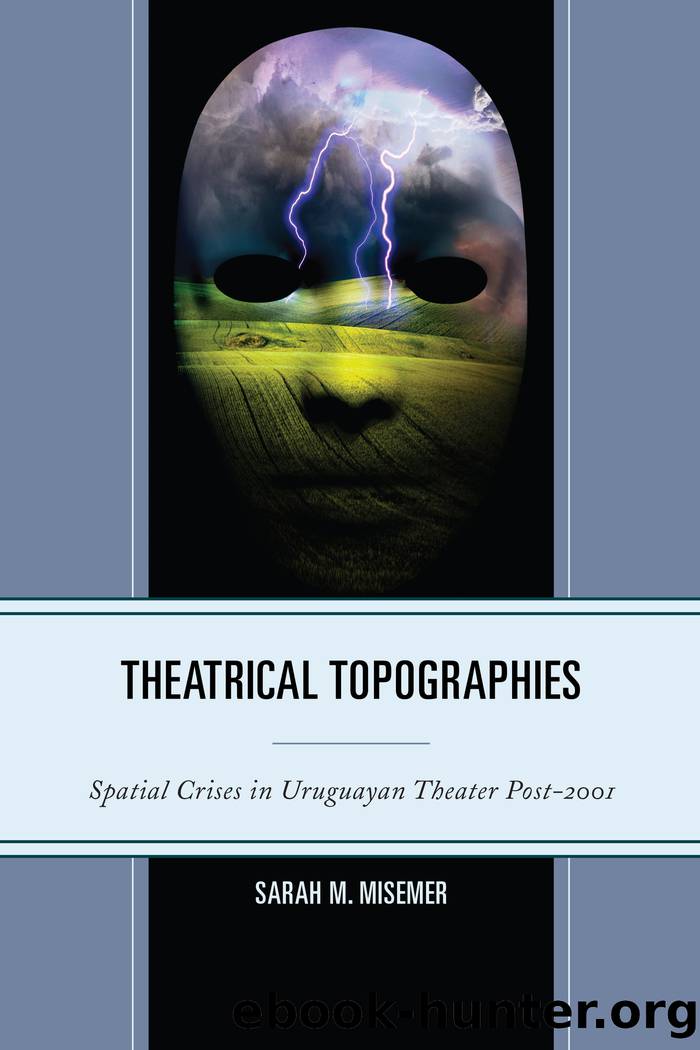Theatrical Topographies by Misemer Sarah M.;

Author:Misemer, Sarah M.;
Language: eng
Format: epub
Tags: undefined
Publisher: Bucknell University Press
Published: 2012-08-15T00:00:00+00:00
These scholars found common ground between midrash and literary studies, and for Stern this commonality is connected to the establishment of a secular identity for Jews.[20]
Others like Terence Wright choose to contextualize midrash in a much broader temporal and cultural frame. Wright contends that â[i]t is the practice of intertextuality rather than its independence that links midrash with modern literary theory.â[21] Because the Bible is replete with midrashic material itself, the process for midrash is the same: âallowing for the continual supplementation and renewal of the tradition.â[22] In other words, the fad for midrashic literary studies that Stern envisions as a product of the 1980s obsession with postmodernity and interdisciplinary studies has a much longer trajectory for critics like Wright. Wright goes on to trace a predilection for midrash as praxis through studies on intertextuality by critics Julia Kristeva, Mikhail Bakhtin, Harold Bloom, and Jacques Derrida, thus extending the temporal range of fascination with midrash from Sternâs 1980s. Wright also cites others like Michael Fishbane, who find the Bible itself as the primary source for âinner-biblical exegesis,â[23] thus further questioning Sternâs claim and separating the sequence of midrashâs rise to popularity from the decade of the 1980s.
However one chooses to couch the importance and evolution of midrash within scriptural or secular literary studies, the impact of the questions and the processes for understanding texts that it raises cannot be overlooked. What matters for this study on Sanguinettiâs Ararat is not the fixing of dates or the theoretical movement with which we choose to analyze it but rather the importance of establishing how midrashâs praxis aligns with the format it provides for contemplating the performance of improvisation and its non-static commentary on âprovidentialâ discourses like the Bible or Hitlerâs Final Solution. If we see polysemy as the underlying foundation of midrash, then the possibility of a univocal interpretation is impossible.[24] We must also remember that because both the Bible and midrash were once oral, the act of writing the formal book made manifest the divide between two âcomplementary, distinct strands of spiritual wisdom.â[25]
I see this division as one that is akin to the division between text and performance in theatrical spectacles. The written dialogue and stage directions are invariant while each performance is unique. Thus, the foundation of theater is built on a live and variable exposition of the text in the theater night after night. At its heart, performance seeks to fill (or does so, perhaps, unknowingly) the cracks and crevices left open in the dramatic text in much the same way that midrash expounds upon these lacunae in the Bible. The one cannot exist without the other, and yet they exert different pressures on the dramatic spectacle.
Yaïr Lipshitz has also examined similar underpinnings of midrash and theater while looking at classic Hebrew plays. Lipshitz acknowledges that many have referred to Jewish communities as textual communities because of their insistence on hermeneutic activities. Yet, Lipshitz explores Jewish plays from the Renaissance period to reveal the âability of theatre as a medium to create its own specific Midrashâ[26] (original emphasis).
Download
This site does not store any files on its server. We only index and link to content provided by other sites. Please contact the content providers to delete copyright contents if any and email us, we'll remove relevant links or contents immediately.
Phoenicians among Others: Why Migrants Mattered in the Ancient Mediterranean by Denise Demetriou(583)
Verus Israel: Study of the Relations Between Christians and Jews in the Roman Empire, AD 135-425 by Marcel Simon(580)
Caesar Rules: The Emperor in the Changing Roman World (c. 50 BC â AD 565) by Olivier Hekster(564)
american english file 1 student book 3rd edition by Unknown(546)
Basic japanese A grammar and workbook by Unknown(511)
Europe, Strategy and Armed Forces by Sven Biscop Jo Coelmont(509)
Banned in the U.S.A. : A Reference Guide to Book Censorship in Schools and Public Libraries by Herbert N. Foerstel(474)
Give Me Liberty, Seventh Edition by Foner Eric & DuVal Kathleen & McGirr Lisa(472)
The Roman World 44 BC-AD 180 by Martin Goodman(465)
Reading Colonial Japan by Mason Michele;Lee Helen;(461)
DS001-THE MAN OF BRONZE by J.R.A(455)
The Dangerous Life and Ideas of Diogenes the Cynic by Jean-Manuel Roubineau(445)
Introducing Christian Ethics by Samuel Wells and Ben Quash with Rebekah Eklund(443)
Imperial Rome AD 193 - 284 by Ando Clifford(436)
The Oxford History of World War II by Richard Overy(436)
Literary Mathematics by Michael Gavin;(400)
Catiline by Henrik Ibsen--Delphi Classics (Illustrated) by Henrik Ibsen(396)
Language Hacking Mandarin by Benny Lewis & Dr. Licheng Gu(391)
How to Reach the 9.0 in IELTS Academic Reading by IELTS Medical(364)
